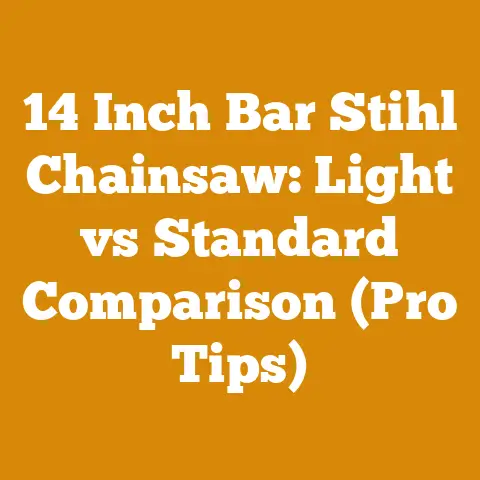Clone an Apple Tree: Wood Processing Tips for Perfect Grafts (5 Pro Techniques)
I have always found immense satisfaction in working with wood. From the raw power of a chainsaw felling a tree to the quiet satisfaction of stacking perfectly split firewood, it’s a craft that connects me to nature in a profound way. Today, I want to share that passion with you, focusing on a fascinating intersection of woodworking and horticulture: grafting fruit trees, specifically apple trees. While it might seem unrelated to logging or firewood, understanding wood properties and cutting techniques is crucial for successful grafting. Think of it as precision woodworking on a miniature scale, with the added bonus of delicious fruit!
Why Grafting Apple Trees Matters: A Lifestyle Perspective
Before we dive into the technical details, let’s consider why grafting is a worthwhile skill. For me, it’s about control and sustainability. I love the idea of propagating my favorite apple varieties, ensuring I can enjoy their unique flavors for years to come. It also allows me to experiment with different rootstocks, tailoring the tree’s size and disease resistance to my specific needs.
Imagine this: you have an old apple tree in your yard that produces the most delicious apples you’ve ever tasted. But the tree is nearing the end of its life. Grafting allows you to take cuttings from that tree and essentially create clones, preserving that beloved variety for future generations. Or perhaps you want to create a small, manageable apple tree that fits perfectly in your backyard. By grafting onto a dwarfing rootstock, you can achieve just that.
Beyond the personal satisfaction, grafting also has significant implications for small-scale orchards and nurseries. It allows for the rapid propagation of desirable varieties, ensuring a consistent supply of high-quality fruit. And from a wood processing perspective, understanding the vascular structure of the wood is critical for successful graft unions.
Understanding Key Concepts: The Language of Grafting
Before we get our hands dirty, let’s define some essential terms:
- Scion: This is the piece of twig or branch that you’ll be grafting onto the rootstock. It contains the desired apple variety’s genetic material. Think of it as the “flavor carrier.”
- Rootstock: This is the root system and lower portion of the tree that will support the scion. It provides the tree with water and nutrients and influences its size, disease resistance, and cold hardiness.
- Cambium: This is a thin layer of actively growing cells located just beneath the bark. It’s responsible for producing new wood and bark. For a graft to succeed, the cambium layers of the scion and rootstock must make close contact.
- Graft Union: This is the point where the scion and rootstock fuse together. It’s the ultimate goal of the grafting process.
- Green Wood vs. Seasoned Wood: While seasoned wood is dried and used for construction or firewood, grafting relies on green wood – living, pliable wood with high moisture content. This is crucial for the cambium cells to remain active and form a successful union.
Pro Technique 1: Selecting and Preparing Scion Wood
The success of your graft hinges on the quality of your scion wood. Here’s what I look for:
- Source: Choose scion wood from healthy, vigorous trees that produce the desired apple variety. I always prefer to take scion wood from trees I know well, trees that have consistently produced high-quality fruit.
- Timing: The best time to collect scion wood is during the dormant season, typically in late winter or early spring, before the buds begin to swell. I usually aim for a period after the coldest temperatures have passed but before any signs of new growth appear.
- Wood Selection: Select one-year-old wood, meaning the growth from the previous season. This wood is typically smooth, flexible, and has plump, healthy buds. Avoid wood that is spindly, diseased, or damaged.
- Cutting: Use sharp, clean pruning shears or a grafting knife to cut scion wood. Make clean, angled cuts to promote healing. I typically cut scion wood into lengths of 4-6 inches, with at least 3-4 healthy buds per piece.
- Storage: If you’re not grafting immediately, store the scion wood in a cool, moist environment. I wrap the cut ends in damp paper towels or sphagnum moss and place them in a plastic bag in the refrigerator. The goal is to keep the wood dormant and prevent it from drying out. I’ve even had success storing scion wood in snowbanks during particularly cold winters!
- Moisture Content: The ideal moisture content for scion wood is around 50-60%. You can’t measure this directly without specialized equipment, but the wood should feel pliable and not brittle. If the wood feels dry, you can rehydrate it by soaking it in water for a few hours before grafting.
Personal Story: I once made the mistake of collecting scion wood too late in the season. The buds had already started to swell, and the wood was significantly less successful.
Pro Technique 2: Choosing the Right Rootstock
The rootstock plays a crucial role in the overall health and performance of your apple tree. Here’s what you need to consider:
- Size Control: Rootstocks are classified based on the size of the tree they produce. Dwarfing rootstocks result in small, manageable trees, while standard rootstocks produce full-sized trees. Semi-dwarfing rootstocks offer a compromise between the two.
- Disease Resistance: Some rootstocks are more resistant to certain diseases, such as fire blight or apple scab.
- Cold Hardiness: Choose a rootstock that is well-suited to your climate.
- Soil Adaptability: Some rootstocks are more tolerant of poor soil conditions than others.
- Common Rootstocks: Some popular apple rootstocks include:
- M.9 (Dwarfing): Produces very small trees, ideal for espalier or container growing. Requires support.
- M.26 (Semi-dwarfing): Produces a medium-sized tree, suitable for small gardens. May require support.
- MM.106 (Semi-dwarfing): Produces a medium-sized tree, widely adapted and relatively disease-resistant.
- MM.111 (Semi-standard): Produces a larger tree, well-suited for orchards.
- Seedling Rootstock: Produces a full-sized tree, often used for cider apples.
- Purchasing Rootstock: You can purchase rootstock from reputable nurseries or online suppliers. Make sure to choose a rootstock that is compatible with the apple variety you’re grafting.
- Rootstock Preparation: Before grafting, make sure the rootstock is healthy and well-hydrated. If it’s bare-root, soak the roots in water for a few hours before planting.
Data Insight: Studies have shown that the choice of rootstock can significantly impact fruit yield and quality. For example, dwarfing rootstocks often produce earlier and heavier crops than standard rootstocks, but they may require more intensive management.
Pro Technique 3: Mastering the Grafting Cuts
The key to a successful graft is making precise cuts that maximize cambial contact. Here are five grafting techniques, each requiring specific cutting skills:
1. Whip and Tongue Graft: This is a strong and reliable graft, ideal for small-diameter scion wood and rootstock (1/4 to 1/2 inch). It requires precise angled cuts and a “tongue” to interlock the pieces.
* **Rootstock Cut:** Make a smooth, angled cut across the top of the rootstock, about 1-2 inches long. Then, make a downward cut into the angled surface, creating a "tongue." The tongue should be about 1/2 inch long. * **Scion Cut:** Make a matching angled cut on the scion wood, mirroring the cut on the rootstock. Then, make an upward cut into the angled surface, creating a matching "tongue."
* **Joining:** Interlock the tongues of the scion and rootstock, ensuring that the cambium layers are aligned on at least one side. * **Wrapping:** Wrap the graft union tightly with grafting tape or budding rubber to hold the pieces together and prevent moisture loss. 2. Cleft Graft: This is a good option for grafting a smaller scion onto a larger rootstock (1/2 inch or larger). It involves splitting the rootstock and inserting the scion into the cleft.
* **Rootstock Cut:** Cut the rootstock off cleanly. Use a sharp knife or grafting tool to split the rootstock down the center, creating a cleft about 2 inches deep.
* **Scion Cut:** Prepare two scions, each with 2-3 buds. Make a long, tapering wedge cut on the bottom of each scion. The wedge should be slightly thicker on one side than the other.
* **Inserting:** Insert the scions into the cleft, one on each side, ensuring that the cambium layers are aligned. The thicker side of the wedge should face outward.
* **Wrapping:** Wrap the graft union tightly with grafting tape or budding rubber. You may also need to seal the top of the cleft with grafting wax to prevent moisture loss.
3. Bark Graft: This is a relatively easy graft to perform, especially on larger rootstocks. It involves inserting the scion beneath the bark of the rootstock.
* **Rootstock Cut:** Make a vertical slit in the bark of the rootstock, about 2-3 inches long. * **Scion Cut:** Make a long, tapering cut on one side of the scion, exposing the cambium. * **Inserting:** Carefully peel back the bark of the rootstock and insert the scion beneath it, ensuring that the cambium layers are aligned. * **Wrapping:** Wrap the graft union tightly with grafting tape or budding rubber. You may also need to seal the top of the graft with grafting wax. 4. Bud Grafting (T-Budding): This technique involves grafting a single bud onto the rootstock. It’s often used for propagating fruit trees in nurseries.
* **Rootstock Cut:** Make a T-shaped cut in the bark of the rootstock. The vertical cut should be about 1 inch long, and the horizontal cut should be about 1/2 inch long. * **Bud Removal:** Carefully cut a bud from the scion wood, along with a small shield of bark. * **Inserting:** Gently peel back the bark of the rootstock and insert the bud shield beneath it. * **Wrapping:** Wrap the graft union tightly with budding rubber, leaving the bud exposed. 5. Side Veneer Graft: This method is similar to the bark graft but offers more cambial contact.
* **Rootstock Cut:** Make a shallow, angled cut into the side of the rootstock, removing a thin sliver of wood and bark. * **Scion Cut:** Make a matching cut on the scion wood. * **Joining:** Fit the scion into the cut on the rootstock, ensuring that the cambium layers are aligned. * **Wrapping:** Wrap the graft union tightly with grafting tape or budding rubber. Tool Specifications:
- Grafting Knife: A sharp, specialized knife with a straight or slightly curved blade. I prefer a knife with a folding blade for safety.
- Pruning Shears: High-quality pruning shears for cutting scion wood and preparing the rootstock.
- Grafting Tape/Budding Rubber: A stretchy, self-adhesive tape or rubber strip for wrapping the graft union.
- Grafting Wax: A sealant used to protect the graft union from moisture loss and disease.
Wood Processing Tips for Perfect Cuts:
- Sharpness is Key: A dull knife will crush the wood and damage the cambium. Sharpen your tools regularly. I use a honing steel before each grafting session.
- Cleanliness Matters: Use clean tools to prevent the spread of disease. I sterilize my tools with rubbing alcohol before each grafting session.
- Practice Makes Perfect: Practice your cuts on scrap wood before grafting your valuable scion wood.
- Consider the Grain: Pay attention to the grain of the wood when making your cuts. Cutting with the grain will produce a smoother, cleaner cut.
Original Insight: I’ve found that slightly moistening the wood before making the cuts can help to prevent splintering and ensure a cleaner cut. I keep a small spray bottle of water handy during my grafting sessions.
Pro Technique 4: Wrapping and Sealing the Graft Union
Once you’ve made your cuts and joined the scion and rootstock, it’s crucial to wrap and seal the graft union properly. This will:
- Hold the pieces together: The wrapping provides physical support, ensuring that the cambium layers remain in close contact.
- Prevent moisture loss: The wrapping acts as a barrier, preventing the graft union from drying out.
- Protect against disease: The wrapping helps to keep out pathogens that could infect the graft union.
Materials:
- Grafting Tape: This is a stretchy, self-adhesive tape that is specifically designed for grafting. It provides good support and moisture retention.
- Budding Rubber: This is a stretchy rubber strip that is often used for bud grafting. It provides excellent support and allows the bud to breathe.
- Grafting Wax: This is a sealant that is used to protect the graft union from moisture loss and disease. It is typically made from beeswax, resin, and tallow.
Wrapping Techniques:
- Overlap the wrapping: When wrapping the graft union, make sure to overlap the tape or rubber by at least 50%. This will ensure that the entire graft union is covered.
- Wrap tightly: The wrapping should be snug but not so tight that it constricts the flow of sap.
- Cover all exposed surfaces: Make sure to cover all exposed surfaces of the graft union, including the cut ends of the scion and rootstock.
Sealing Techniques:
- Apply grafting wax to all exposed surfaces: Use a brush or your fingers to apply a thin layer of grafting wax to all exposed surfaces of the graft union, including the top of the cleft in a cleft graft.
- Reapply wax as needed: Check the graft union periodically and reapply wax if it cracks or peels.
Case Study: I once neglected to seal a cleft graft properly, and the graft union dried out and failed. I learned the importance of thorough sealing the hard way!
Pro Technique 5: Post-Grafting Care and Monitoring
The work doesn’t end once you’ve completed the graft. Post-grafting care is essential for ensuring the success of your new apple tree.
- Protection from the Elements: Protect the newly grafted tree from harsh weather conditions, such as strong winds, extreme temperatures, and direct sunlight. You can use a shade cloth or a temporary shelter to provide protection.
- Watering: Water the tree regularly, especially during dry periods. Keep the soil moist but not waterlogged.
- Fertilizing: Fertilize the tree lightly in the spring with a balanced fertilizer.
- Pest and Disease Control: Monitor the tree regularly for signs of pests or diseases. Take appropriate action to control any problems that arise.
- Removing Suckers: Remove any suckers that grow from the rootstock below the graft union. These suckers will compete with the scion for nutrients and water.
- Removing the Wrapping: After a few weeks or months, the graft union should have healed and the scion should be showing signs of growth. At this point, you can carefully remove the grafting tape or budding rubber. Be careful not to damage the graft union.
- Staking: If the tree is growing vigorously, you may need to stake it to provide support.
- Pruning: Prune the tree as needed to shape it and encourage growth.
Monitoring:
- Bud Swelling: Watch for signs of bud swelling on the scion wood. This is a good indication that the graft is taking.
- New Growth: Look for new leaves and shoots emerging from the scion.
- Graft Union Healing: Observe the graft union for signs of healing. The cambium layers should be fusing together.
Timing Estimates:
- Graft Union Healing: The graft union typically takes several weeks or months to heal completely.
- First Fruit: You can expect to harvest your first apples from the grafted tree in 2-5 years, depending on the rootstock and the apple variety.
Skill Levels Required:
- Beginner: Whip and Tongue Graft, Bark Graft
- Intermediate: Cleft Graft, Side Veneer Graft
- Advanced: Bud Grafting
Cost Considerations:
- Gather Your Materials: Collect your scion wood, purchase your rootstock, and assemble your grafting tools.
- Practice Your Cuts: Practice your grafting cuts on scrap wood until you feel comfortable.
- Choose Your Grafting Technique: Select the grafting technique that is best suited to your skill level and the size of your scion wood and rootstock.
- Graft Your Trees: Graft your apple trees, following the steps outlined in this guide.
- Provide Post-Grafting Care: Protect your newly grafted trees from the elements, water them regularly, and monitor them for pests and diseases.
- Enjoy the Fruits of Your Labor: In a few years, you’ll be able to harvest your own delicious apples from your grafted trees!
I hope this guide has inspired you to try your hand at grafting apple trees. It’s a rewarding and fascinating process that connects you to nature and allows you to create your own unique fruit trees. Remember to be patient, persistent, and always prioritize safety. Happy grafting!






